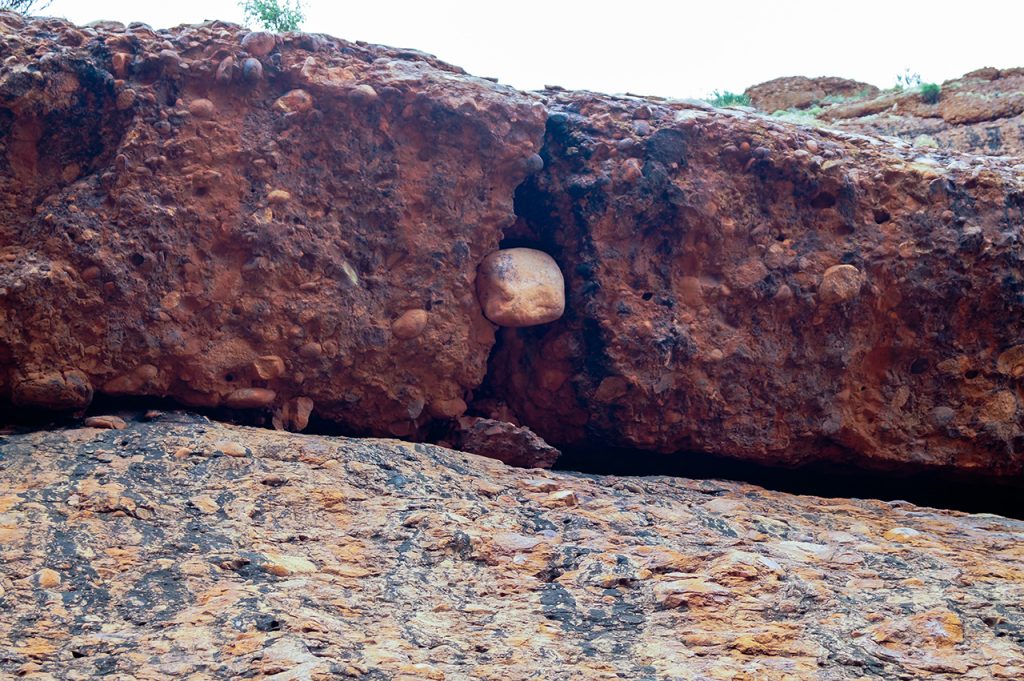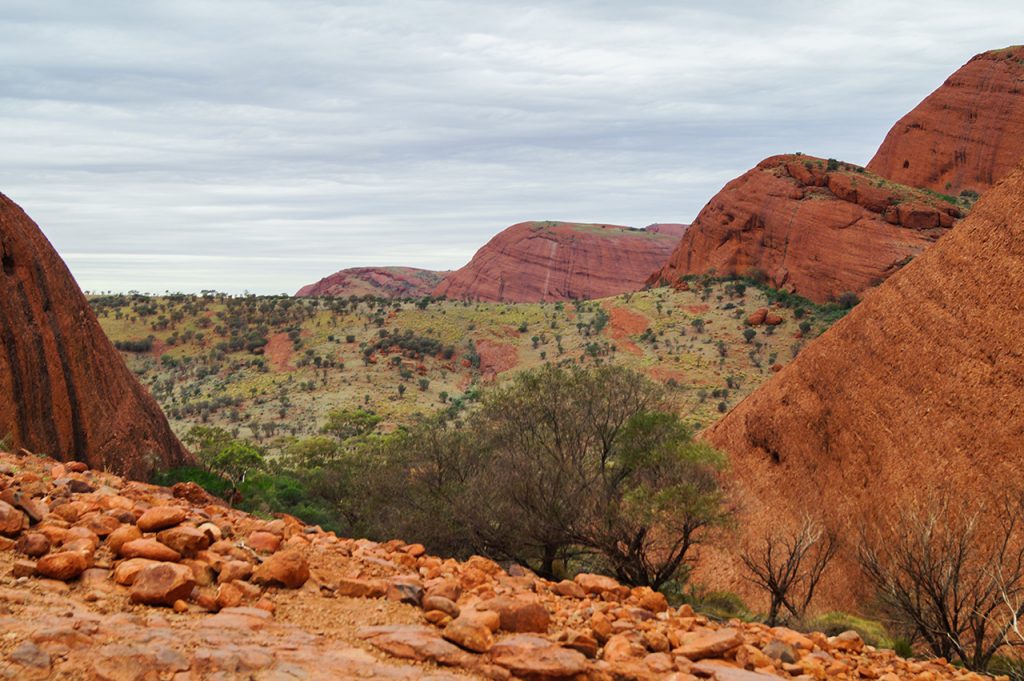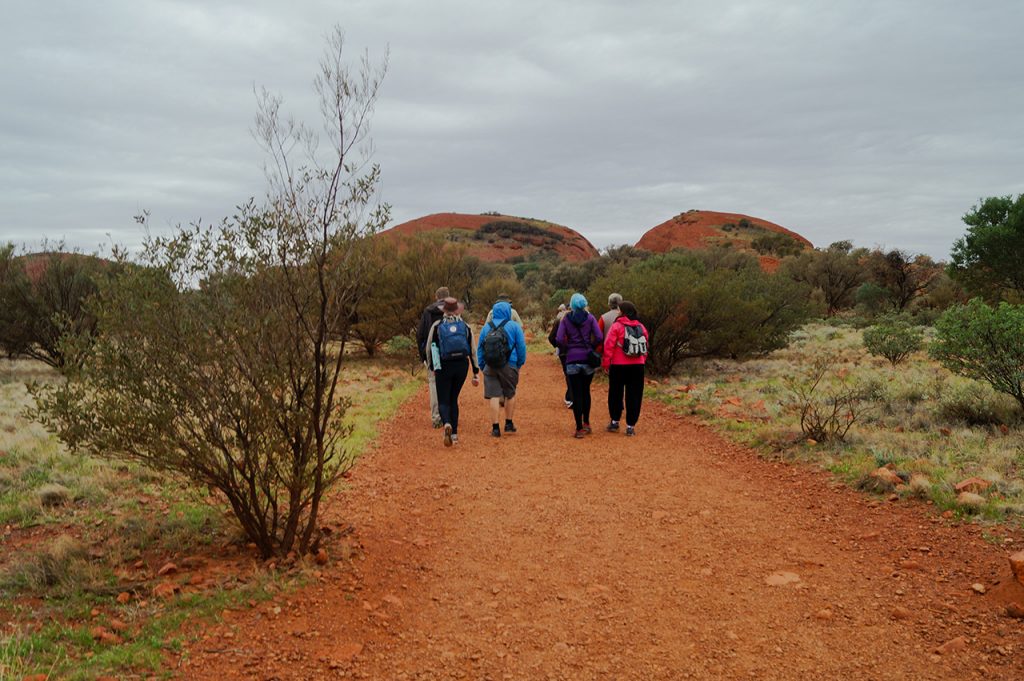Alongside Uluru, Kata Tjuta is one of the major and more famous landmarks that can be found in the red centre of Australia. Commonly referred to as the Olgas, the massive rock formation boasts a ridiculous number of beautiful views, and has plenty of easy to access walking routes for you to explore. They’re all rather easy routes, with nothing too strenuous aside from the occasional incline – nothing excessive, and the reward for exploring it all is most certainly worth it.
Kata Tjuta is a lot more than just pretty sites though. The area holds cultural significance to the local aboriginal tribes, and the rock’s history changes depending on who you choose to ask.

Where is Kata Tjuta?
Kata Tjuta/The Olgas can be found in the Uluru-Kata Tjuta National Park which is in Australia’s red centre. The rock formation can be found 365 kilometres (or 227 miles) southwest of Alice Springs which is the closest relatively large settlement, and although it lies in the Northern Territory, it’s pretty much central Australia.
If you travel 25 kilometres (or 16 miles) to the east, you’ll come across Uluru (Otherwise known as Ayers Rock) which has a similar geological make up and important cultural heritage for many aboriginal people.
As you’re travelling through the red centre, you’ll learn how it got it’s name. The red dust gets everywhere, and was meant to turn my boots red – I was looking forward to having red boots, but it didn’t work out.

Why is it called Kata Tjuta?
The group of domed rocks (36 to be precise) is called Kata Tjuta because the local pitjantjatjara people named it, in typical aboriginal naming style, after what it looks like. The words Kata Tjuta literally translate to mean “many heads”. It makes perfect sense when you think about it. It used to go by an alternative name, ‘The Olgas’, which comes from the tallest mountain – Mount Olga. Mount Olga was named in honour of Queen Olga of Württemberg, by Ernest Giles.
To clarify, it was named Kata Tjuta by the indigenous locals long before Mount Olga was named in 1872.
It became officially known as Mount Olga/Kata Tjuta before it was switched to “Kata Tjuta/Mount Olga” in 2002, honouring the aboriginal naming of their sacred site.
How was Kata Tjuta Formed?
A brief history lesson here. Approximately 550 million years ago Kata Tjuta was formed when a volcanic thrust lifted the rock. Kata Tjuta is mostly made up of conglomerate, which is a mixture of smaller rocks and boulders made of granite and basalt that are cemented together by a sedimentary rock (in this case sandstone). The rock gets its colouring from the iron-oxide coated feldspar (iron oxide being rust, hence the rusty colour).

They were eventually weathered down and the softer sedimentary rock which binds Kata Tjuta together began to erode and resulted in the massive formation that you can see today. This lovely picture gives a pretty good idea of what I mean by the conglomerate rock being cemented together.
The short version is that it formed via erosion of a conglomerate containing basalt, granite, gneiss and porphyry.

How big is Kata Tjuta?
The domes are spread over an area greater than 20 kilometres or 12 miles, and the tallest peak – Mount Olga – is 3,497 feet above sea level. That’s just over 1km above sea level (1,066 metres) and is 1,791 feet or 546 metres above the rest of the surrounding outback.
Mount Olga is even higher than Uluru by almost 200 metres.
In the past Kata Tjuta would have been even larger, but since it formed around 550 million years ago it’s had plenty of time exposed to the elements, and although the outback doesn’t currently receive a lot rain, it will have eroded slowly due to the wind and water that beat against the rock face for millions of years.

Why is Kata Tjuta Sacred?
As with most important places with aboriginal cultural significance, there are stories which relate to dream time which explain why the site is sacred and of importance to the local tribes.
Kata Tjuta is an Anangu site, and the Anangu people consider it a men’s site that is sacred under Tjukurpa (aboriginal law). This means that a lot of the legends that surround the site are only disclosed to the aboriginal men – very few outsiders get to learn of the actual stories and beliefs, and with a men’s site this will almost never be a woman.
The most well known and told story involving Kata Tjuta tells of the great snake king Wanambi. Wanambi lives on the summit of Mount Olga and only choose to come down from his home during the dry season.
My interpretation would be that the serpent king, Wanambi, is the same rainbow serpent which laid eggs at Devils Marbles and formed the gullies, rivers and billabongs across Australia, but whether I’m correct only the aboriginal people will know.

Everyone is welcome to visit Kata Tjuta, but as with Uluru it would be best to stay within the designated areas and be respectful of the importance the site has in aboriginal culture – similar areas are cordoned off around Australia for the same reason, including the paintings at Yourambulla.
Is Kata Tjuta Accessible?
There are walks nearby that are wheelchair accessible and offer amazing views, particularly at sunrise and sunset. They’re not particularly long and will take about half an hour to complete. The cover image (which I ineptly cropped with my camera) is taken from one of these spots.

There are other walks at the site which are more challenging but only moderate. They’re usually a couple of kilometres long and will only take an hour or two.
I’d recommend doing at least one of the walks, and if you have chance take the time to watch sunrise or sunset from the dune viewing area.
If you want to know more about the various walks you can do and the area surrounding Kata Tjuta then you can find more information on the parks Australia website.
As always, make sure you take plenty of water with you when you’re bush walking, the sun might feel good to begin with but it can quickly become a killer.